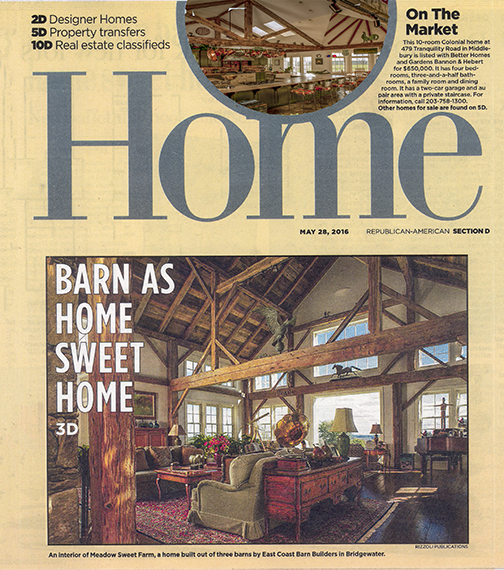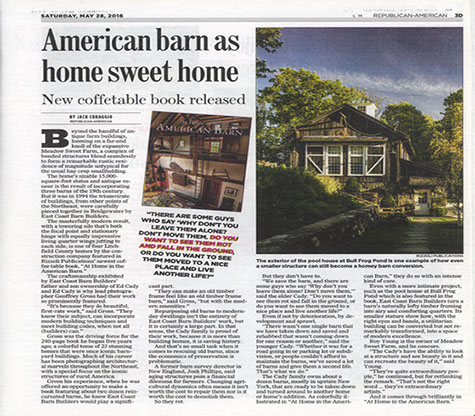Geoffrey Gross
Photography


At Home in the American Barn
BY JACK CORAGGIO
REPUBLICAN-AMERICAN
Beyond the handful of antique farm buildings, looming on a far-end knoll of the expansive Meadow Sweet Farm, a complex of bonded structures blend seamlessly to form a remarkable rustic residence of magnitude untypical for the usual hay crop smallholding.
The home’s sizable 15,000square-foot status and antique veneer is the result of incorporating three barns of the 19th century. But it was in 1994 the triumvirate of buildings, from other points of the Northeast, were carefully pieced together in Bridgewater by East Coast Barn Builders.
The masterfully modern result, with a towering silo that’s both the focal point and stationary hinge with equally impressive living quarter wings jutting to each side, is one of four Litchfield County homes by the construction company featured in Rizzoli Publications’ newest coffee table book, “At Home in the American Barn.”
The craftsmanship exhibited by East Coast Barn Builders’ father and son ownership of Ed Cady and Ed Cady is why lead photographer Geoffrey Gross had their work so prominently featured.
“It’s because they do beautiful, first-rate work,” said Gross. “They know their subject, can incorporate modern building techniques and meet building codes, when not all (builders) can.”
Gross was the driving force for the 240-page book he began five years ago; a colorful tome of 23 stunning homes that were once iconic barnyard buildings. Much of his career has been photographing architectural marvels throughout the Northeast, with a special focus on the iconic structures of rural America.
Given his experience, when he was offered an opportunity to make a book featuring about two dozen reincarnated barns, he knew East Coast Barn Builders would play a significant part. “They can make an old timber frame feel like an old timber frame barn,” said Gross, “but with the modern amenities.”
Repurposing old barns to modern day dwellings isn’t the entirety of East Coast Barn Builders’ work, but it is certainly a large part. In that sense, the Cady family is proud of their work, because it is more than building homes, it is saving history.
And that’s no small task when it comes to rescuing old barns, since the economics of preservation is problematic.
A former barn survey director in New England, Josh Phillips, said aging structures pose a financial dilemma for farmers. Changing agricultural dynamics often means it isn’t worth the cost to repair them nor is it worth the cost to demolish them.
So they rot.
But they don’t have to.
“We save the barn, and there are some guys who say ‘Why don’t you leave them alone? Don’t move them,’” said the elder Cady. “Do you want to see them rot and fall in the ground, or do you want to see them moved to a nice place and live another life?”
Even if not by deterioration, by development and sprawl.
“There wasn’t one single barn that we have taken down and saved and rehabbed that wasn’t coming down for one reason or another,” said the younger Cady. “Whether it was, for a road going in or parking lot or subdivision, or people couldn’t afford to maintain the barns, we’ve saved a lot of barns and give them a second life. That’s what we do.”
The Cady family owns about a dozen barns, mostly in upstate New York, that are ready to be taken down and turned around to another home or home’s addition. As colorfully illustrated in “At Home in the American
Barn,” they do so with an intense kind of care.
Even with a more intimate project, such as the pool house at Bull Frog Pond which is also featured in the book, East Coast Barn Builders turn a barn’s naturally lofty timber framing into airy and comforting quarters. Its smaller stature shows how, with the right eyes and hands, a utilitarian building can be converted but not remarkably transformed, into a space of modern excellence.!
Roy Young is the owner of Meadow Sweet Farm, and he concurs.
“The Cady’s have the ability to look at a structure and see beauty in it and can recreate the beauty of it,” said Young.
“They’re quite extraordinary people,” he continued, but for rethinking the remark. “That’s not the right word ... they’re extraordinary artists.”
And it comes through brilliantly in “At Home in the American Barn.”
“THERE ARE SOME GUYS WHO SAY ‘WHY DON’T YOU LEAVE THEM ALONE? DON’T MOVE THEM.
DO YOU WANT TO SEE THEM ROT AND FALL IN THE GROUND,
OR DO YOU WANT TO SEE THEM MOVED TO A NICE PLACE AND LIVE ANOTHER LIFE?”


